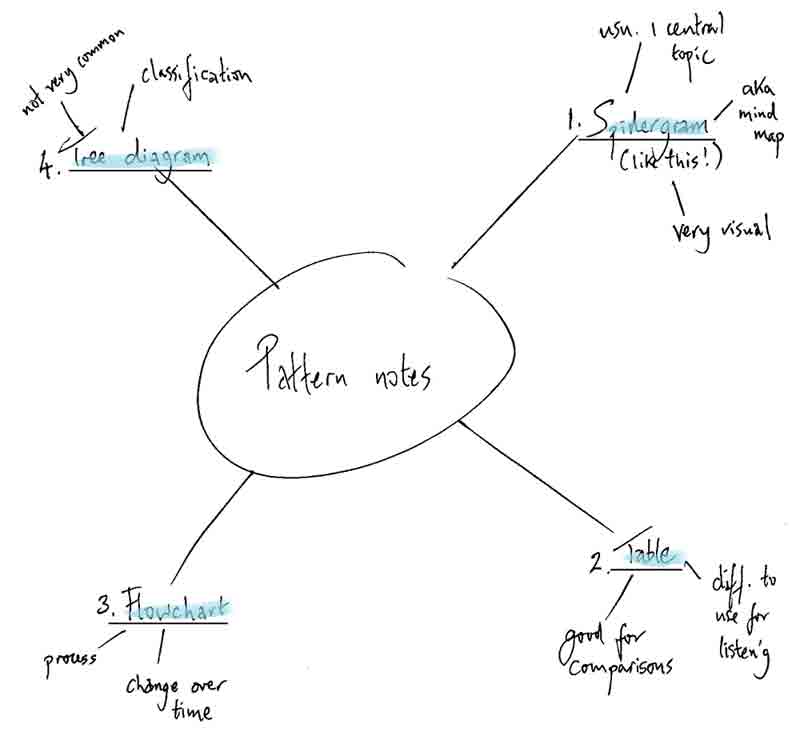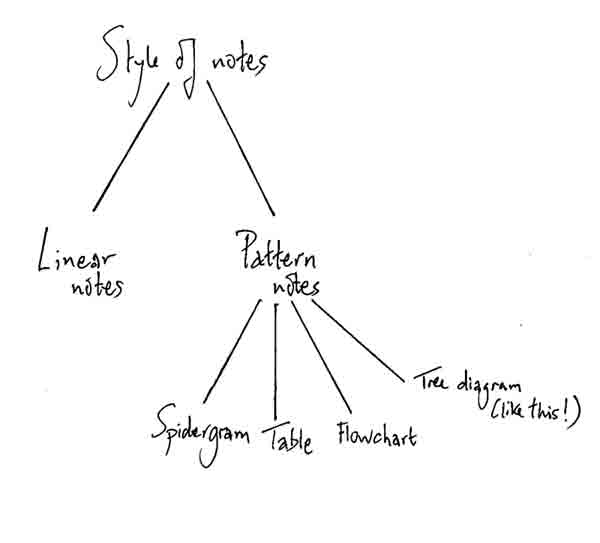Notes Style
Note: The information on this page is mostly repeated from the listening and note-taking section. Styles of notes for reading are the same as for listening.
The main reason for taking notes is to be able to use them later, for example in exams or in your academic writing. It is therefore important not only for you to understand how to note the main points accurately, but also how to note them with a clear organisation, which the relationship between the ideas clearly shown. This page describes two different ways to organise your notes, namely linear notes and pattern notes.
Linear notes
Linear notes are the simplest and therefore the most common style of notes, both for reading and listening. The word linear is the adjective of the word line, which indicates that these notes are written down the page, one line after the other. This type of notes is sometimes called outline notes as they are similar in format to the outline of an essay. Two common features of this style of notes are the use of:
- numbering or lettering;
- indentation.
The use of numbering/lettering and indentation is important to help distinguish the main points from the minor ones. The use of indentation also helps to make the information more visual, which is useful for visual learners (although of course linear notes are not as visual as pattern notes, described in more detail below). An example of linear notes, for information on this page, is given below.
1. Linear notes
- go down the page
- use letters/numbers
- use indenting
2. Pattern notes
- more visual
- several types
a) Spidergram
b) Flowchart
c) Table
d) Tree diagram
From the above, it can easily be seen that there are two main topics (linear notes and pattern notes). These are indicated both by the use of numbering (1, 2) and indenting (all the other information is moved across the page, to the right of these ideas). Both of the main ideas have several supporting points. As these are not in any kind of sequence or order, there is no need to use lettering or numbering, and in this case a dash is used to indicate each point. For the second main point (pattern notes), four types are given, indicated by a combination of lettering (a, b, c, d) and indenting.
When using lettering, it is possible to use capital or small letters, or large or small roman numerals, as shown in the table below.
| Numbers | 1, 2, 3, 4, 5, ... |
| Large roman numerals | I, II, III, IV, V, VI, VII, VIII, IX, X, ... |
| Small roman numerals | i, ii, iii, iv, v, vi, vii, viii, ix, x, ... |
| Capital letters | A, B, C, D, E, ... |
| Small letters | a, b, c, d, e, ... |
These can be used in any combination which you prefer, though for clarity it is important to make sure each level uses a different system. The notes above, using a different combination of numbers/letters, could look like this:
A. Linear notes
- go down the page
- use letters/numbers
- use indenting
B. Pattern notes
- more visual
- several types
i. Spidergram
ii. Flowchart
iii. Table
iv. Tree diagram
The main advantage of linear notes is that they are usually very clear, especially when there is a clear structure to the reading text (or lecture for listening and note-taking). The main disadvantage is that they are not as interesting or visual as pattern notes, which means the information may be less memorable.
Pattern notes
Pattern notes are notes which are not linear and therefore have some distinctive pattern. There are four main types considered here, which are spidergram, table, flowchart and tree diagram.
Spidergram
A spidergram, also known as a mind map, is a diagram in which ideas are linked to each other by lines, usually starting from the middle and working outwards, making the diagram look a little like the web of a spider (spidergram is a combination of the words spiderweb and diagram). Although it can be used at any time, it is best when there is one central topic with several sub-topics related to it. An example of a spidergram, for information on this page, is given below. In this spidergram, the central topic is pattern notes, and there are four sub-topics, namely the four types of pattern notes described on this page.

The advantages of this style of notes are that it is quick and easy to make, and it is very visual, which makes it ideal for visual learners. It is also easy to add information later. It tends to be briefer than linear notes, which could be both an advantage and a disadvantage.
Table
Another type of pattern notes is a table. This is most commonly used when two different things are compared, and is therefore usually only used for part of a reading text (or lecture). Although it can be difficult to use this style of notes when listening and note-taking, as you need to make a very quick decision of which style to use, it is easier to use when reading and note-taking since you have more time to think before making notes. If two things are being compared, this is definitely an effective form of notes to use, as it makes the similarities and differences very clear. Below is an example of a table, for information on this page.
| Linear notes | Pattern notes |
| Connection between ideas very clear Not very visual May be a little boring Can be difficult to add info later |
Connection between ideas quite clear Very visual Usually quite interesting Usu easy to add info later |
Flowchart
A flowchart is useful if you want to show a process or a change over time. A flowchart usually has steps shown in boxes connected by arrows which show the order. Below is an example of a flowchart, for the process of writing an exam essay.
Tree diagram
A tree diagram is another form of pattern notes. It is called a tree diagram because, if turned upside-down, it resembles a tree. This type of notes has a specific use, which is to show classification. Below is an example of a tree diagram for information on this page. Here it can be seen that notes can be divided into two types, linear and pattern. Pattern notes can be sub-divided into four main kinds, namely spidergram, table, flowchart and tree diagram.
Summary
In short, there are two main styles of notes, linear notes and pattern notes, with pattern notes sub-divided into four main kinds, which are spidergram, table, flowchart and tree diagram. Whichever way you use, you should still try to make the main points as clear as possible, and ensure the connections between ideas are also clear, so that you will be able to use your notes later. Both styles can use headings, underlining, highlighting and space to help make these relationships clear. Although some styles of notes are better suited to particular functions, for example a table when comparing or contrasting, or a flowchart for showing a process, which style you choose will depend on your ability to recognise the best type to use, and also your own personal preference.





